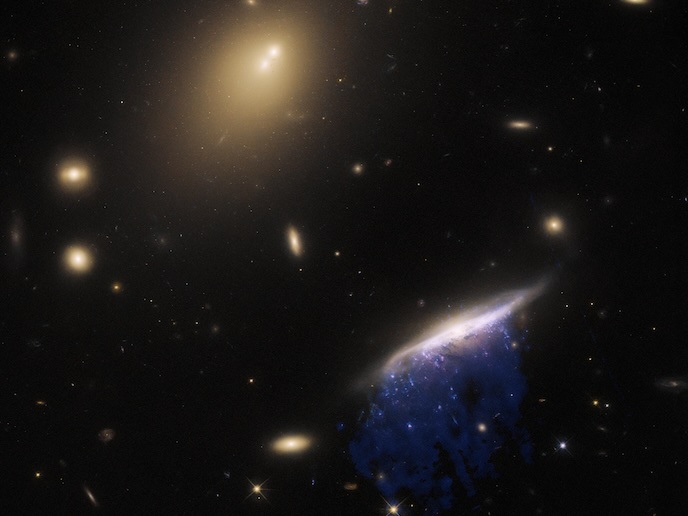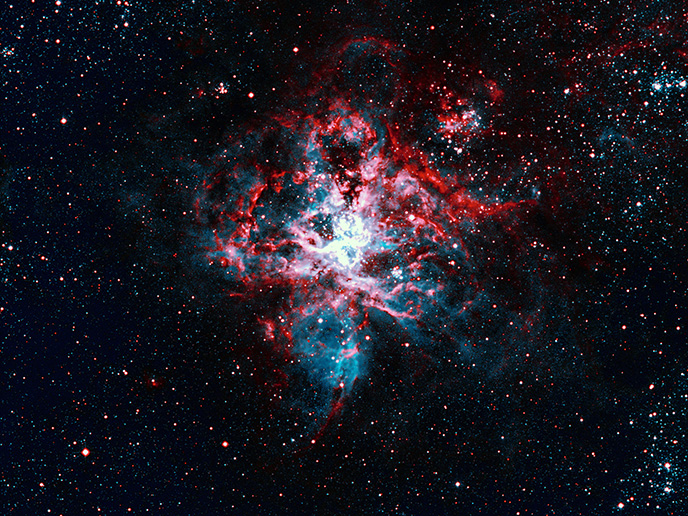How cosmic jellyfish and other galaxies evolve
A 5-year study of galaxies in different parts of the universe has shed light on how the galactic environment affects gas processes that enable galaxies to form new stars and grow in mass. “Gas is a fundamental component in galaxies: it drives everything. The amount of gas in the galaxy decides how much star formation there is; the evolution of the characteristics and mass of the galaxy,” explains project coordinator Bianca Maria Poggianti, director of the Astronomical Observatory of Italy’s National Institute for Astrophysics (INAF) in Padua. The GASP project, which was funded by the European Research Council, used vast amounts of data from the world’s most advanced instrumentation to study the evolving properties of galaxies. These included MUSE (Multi Unit Spectroscopic Explorer), installed at the European Southern Observatory’s Very Large Telescope in Chile. The team then used cutting-edge hydrodynamical simulations to interpret the observational results. “We studied galaxies in different places of the universe, because gas processes depend on where the galaxy is,” Poggianti says, adding 114 galaxies were observed and analysed. “That’s many more than the handful studied with this technique for this field of research before, so it was a huge leap.” Other data was obtained from the Hubble Space Telescope at ultraviolet wavelengths, and from South Africa’s MeerKAT array which detects the neutral hydrogen gas. The Atacama Large Millimeter Array (ALMA) telescope in Chile – which observes electromagnetic radiation at millimetre and smaller wavelengths for molecular gas detection – was another source of data. “We managed to cover many wavelengths for many galaxies to have a more complete view,” Poggianti remarks. She explained that galactic gases can be neutral, ionised or molecular, and thus can be in different phases, temperatures or densities. “You need to understand all the various gas phases to comprehend the cycle between gas and stars,” she notes.
How cluster galaxies lose gas
Busy regions of the universe, such as galaxy clusters, show a process called ram pressure stripping caused by the interaction of hot gas filling the space between galaxies and the gas within the disks of galaxies. These galaxies lose their gas, which is forced into long tails as the hot, dense gas acts like a powerful wind. The most spectacular of these are ‘jellyfish’ galaxies with long tentacles extending for tens of thousands of light years beyond their discs. “When the gas is stripped from that galaxy, it can form new clumps of stars in the tail, forming a beautiful jellyfish,” Poggianti explains. “Jellyfish galaxies are a key to understanding galaxy evolution in clusters, as they are galaxies caught in the middle of a dramatic transformation.” “We studied the star-forming clumps in tails in fantastic detail,” Poggianti says. “There can be a million or even 10 million stars in each clump, so it’s like a small galaxy forming in the tail of this larger galaxy.”
Numbers of active nuclei a surprise
Every galaxy has a black hole at its centre, which in most cases is ‘dormant’, not producing much energy. However, an unexpectedly large number of galaxies undergoing gas stripping turned out to have an active galactic nucleus (AGN). During the AGN phase, the galaxy’s central black hole accretes material and produces a lot of energy observable in different wavelengths. “They are in a moment in the history of galaxies when the central black hole is active. It’s eating the surrounding gas,” Poggianti adds. The team discovered that the gas that is stripped away can cause a change in the galaxy’s structure. For example, some spiral galaxies open up their ‘arms’, called unwinding arms. Later they can change from spirals into lenticular galaxies. These have a disc but without spiral arms. “This clarifies the connection between processes that affect the gas and the galaxy shape,” she adds.
Keywords
GASP, galaxy, jellyfish galaxies, MUSE, telescope, European Southern Observatory, Hubble Space Telescope, Large Millimeter Array, MeerKAT array, ram pressure stripping, black hole, AGN, spiral galaxies, lenticular galaxies







